RF Pulses & Sequences
Oral
Acquisition, Reconstruction & Analysis
Thursday, 21 June 2018
| N03 |
13:15 - 15:15 |
Moderators: Huijun Chen, Joseph Hajnal |
13:15
 |
1127.
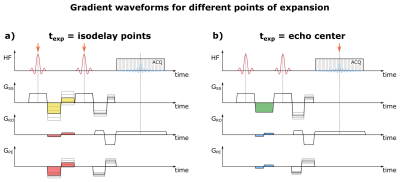 |
 On the Point of Gradient Moment Expansion for Multi-Spoke RF Pulses On the Point of Gradient Moment Expansion for Multi-Spoke RF Pulses
Simon Schmidt, Sebastian Flassbeck, Mark Ladd, Sebastian Schmitter
In this work we investigated the influence of the point of gradient moment expansion (texp) for multi-spoke RF pulses. The results demonstrate that texp=tISO is ideal if no flow in the RO direction is present, but severe displacement artifacts occur if this is the case. texp=TE induces shifts that are directed along the vessel orientation and are independent of the encoding orientation. The presented techniques are the basis for correct velocity quantification with controlled displacement for multi-spoke RF pulses allowing in-plane B1+ homogenization using parallel transmission at UHF.
|
13:27
|
1128.
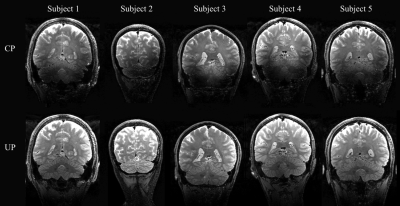 |
 Design of universal parallel-transmit refocusing kT-point pulses and application to 3D T2-weighted imaging at 7T Design of universal parallel-transmit refocusing kT-point pulses and application to 3D T2-weighted imaging at 7T
Vincent Gras, Franck Mauconduit, Alexandre Vignaud, Alexis Amadon, Denis Le Bihan, Tony St÷cker, Nicolas Boulant
The kT-point technique exploits the dynamic RF shimming capability of parallel transmission to uniformly excite the spins. That technique allows homogenizing the flip angle in RF-spoiled sequences but also the rotation angle in sequences involving non-selective refocusing pulses. As far as the flip angle is concerned, it has been shown that so-called universal kT-point pulses can be designed to work robustly on any subject without having to tailor the pulse to the subject. In this study we propose to extend the universality concept to refocusing pulses, and to give an experimental demonstration with 3D fast spin echo brain imaging.
|
13:39
 |
1129.
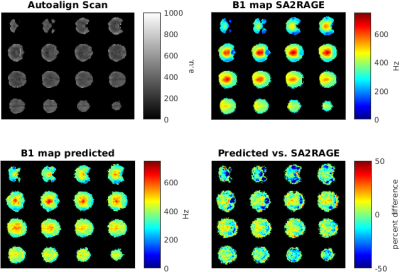 |
 Improving FLAIR SAR efficiency by predicting B1-maps at 7T from a standard localizer scan using deep convolutional neural networks Improving FLAIR SAR efficiency by predicting B1-maps at 7T from a standard localizer scan using deep convolutional neural networks
Steffen Bollmann, Samuel Kelly, Viktor Vegh, Anders Rodell, Yas Tesiram, Markus Barth, Kieran O’Brien
Ultra-high-field (7T) instrumentation offers the possibility of acquiring FLAIR images at an improved resolution when challenges such as efficient B1 calibration and SAR reductions can be realized. Instead of acquiring a separate B1-map, we propose to predict B1-maps based on the implicit B1 inhomogeneity field present in an AutoAlign localizer using deep convolutional neural networks. We show that a 34% reduction in SAR can be achieved by adjusting the power of FLAIR's adiabatic inversion pulse on a slice-by-slice basis using the B1 information without degradation of image quality.
|
13:51
|
1130.
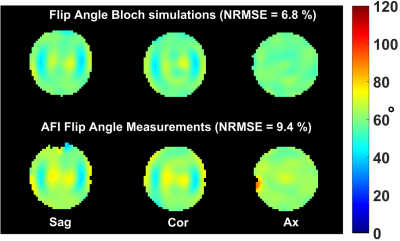 |
 In-vitro demonstration of explicit temperature control using pTx and temperature virtual observation points at 7T In-vitro demonstration of explicit temperature control using pTx and temperature virtual observation points at 7T
Nicolas Boulant, Vincent Gras, Pierre-Franšois Van de Moortele
Recent numerical studies have shown that temperature could be controlled explicitly at the pulse design stage in parallel transmission, furthermore reporting that further scan performance could be gained if the more relevant safety metric that is temperature, instead of the specific absorption rate, was controlled. Bioheat models yet are still undergoing experimental validations. So as a first step, this work reports an experimental demonstration of flip-angle homogenization with temperature control on a water phantom with parallel transmission at 7T.
|
14:03
|
1131.
 |
 Slab-Selective Spectral and Spectral-Spatial Prewinding RF Pulses Slab-Selective Spectral and Spectral-Spatial Prewinding RF Pulses
Sydney Williams, Jon-Fredrik Nielsen, Jeffrey Fessler, Douglas Noll
We introduce a new type of small-tip angle prewinding RF pulse that compensates for spin dephasing attributed to off-resonance and is also slab-selective, which can help limit the volume of coverage. We design purely spectral slab-selective pulses that prewind a limited global off-resonance bandwidth, and spectral-spatial slab-selective pulses that adapt the prewinding bandwidth spatially. We demonstrate these pulse designs in simulation and in experiments using a gel phantom with a distorted field and a volunteer’s brain. Both pulses create sharp slab profiles, while the spectral-spatial pulse outperforms in terms of target magnetization phase.
|
14:15
|
1132.
 |
 Magnetization Transfer effects in Actual Flip angle Imaging Magnetization Transfer effects in Actual Flip angle Imaging
Shaihan Malik, Rui Pedro Teixeira, Joseph Hajnal
The AFI sequence is a robust flip angle mapping method and is used within quantitative MRI protocols. AFI is a modified spoiled gradient echo (SPGR) sequence, employing interleaved TR times of different lengths. It is well known that SPGR signal behaviour is sensitive to Magnetization Transfer effects, so in this work we used a two-pool model to derive signal equations for AFI that include MT. We found that MT will lead to an underestimation of flip angle by up to 6% in white matter and that longer TR and lower RF energy lead to larger bias.
|
14:27
|
1133.
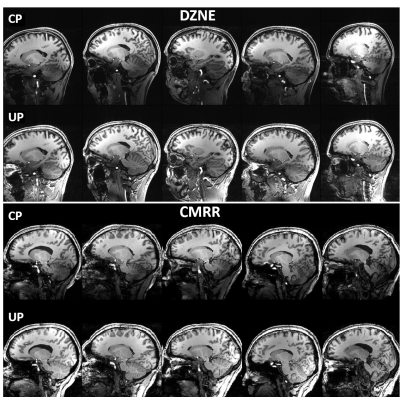 |
 The travelling pulses: multicenter evaluation of universal pulses at 7T The travelling pulses: multicenter evaluation of universal pulses at 7T
Xiaoping Wu, Vincent Gras, Alexandre Vignaud, Franck Mauconduit, Markus Boland, Tony Stoecker, Kamil Ugurbil, Nicolas Boulant
It has been shown recently that parallel transmission universal pulses (UPs), optimized offline on a training field-maps database, can be used to robustly mitigate B1+ inhomogeneity on other subjects, thus holding great potential for spreading their utility by sparing the user the time-consuming individualized calibration. For these UPs to be used widely, however their performance needs to be immune to inter-site differences. In this study, we examined the robustness of the UPs against inter-site variability. Our results so far obtained at two sites show that the UPs are quite robust in producing uniform contrast across the brain despite these differences.
|
14:39
|
1134.
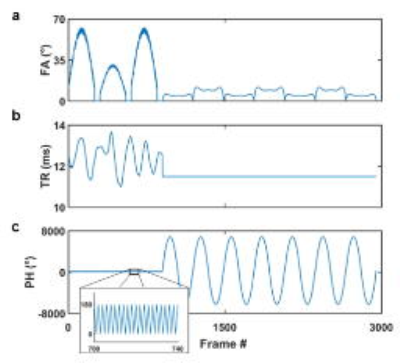 |
 In vivo Simultaneous Measurement of df, T1, T2, and T2* by Magnetic Resonance Fingerprinting with Quadratic RF Phase In vivo Simultaneous Measurement of df, T1, T2, and T2* by Magnetic Resonance Fingerprinting with Quadratic RF Phase
Charlie Wang, Simone Coppo, Bhairav Mehta, Nicole Seiberlich, Xin Yu, Mark Griswold
We propose a novel Magnetic Resonance Fingerprinting pulse sequence with quadratic RF excitation phase (qRF-MRF) for the purpose of simultaneous measurement of T2* in addition to previously established spin parameters δf, T1, and T2. The original bSSFP based MRF pulse sequence1 was modified to incorporate excitation segments with quadratic RF phase to sensitize signal evolutions to T2*. Measurements using qRF-MRF were performed in both phantom and in vivo. Maps from qRF-MRF were validated against bSSFP based MRF and Multi-GRE.
|
14:51
|
1135.
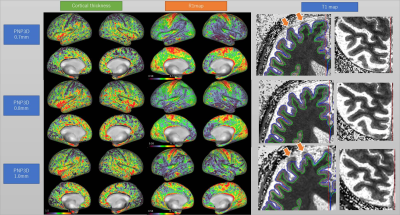 |
 Cortical T1 mapping with 3D MR Fingerprinting at 7T using a single transmit channel Cortical T1 mapping with 3D MR Fingerprinting at 7T using a single transmit channel
Koji Fujimoto, Martijn Cloos, Yuta Urushibata, Tomohisa Okada
A prototype 3D MRF sequence was evaluated for cortical T1 mapping at 7T in the context of the Human Connectome Project (HCP). Phantom results showed that the 3D MRF T1 map of a liquid was in good agreement with gold standard IR-SE measurements. The synthetic MPRAGE and synthetic T2-SPACE created from the 3D MRF data performed well in HCP pipeline. The cortical thickness estimation was fairly stable across different imaging resolutions. The R1 of the cortex showed higher value than expected, which may indicate that more advanced signal models may be necessary to accurately describe the spin dynamics in-vivo.
|
15:03
|
1136.
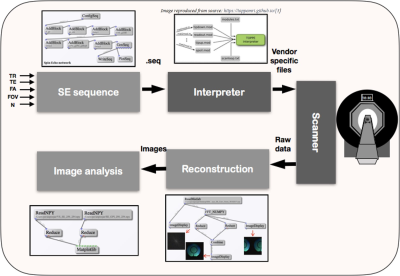 |
 Pulseq-GPI: A single, comprehensive framework for MR method development Pulseq-GPI: A single, comprehensive framework for MR method development
Sneha Potdar, Pavan Poojar, Ashok Reddy, Keerthi Sravan, Stefan Kroboth, Jon-Fredrik Nielsen, Maxim Zaitsev, Ramesh Venkatesan, Sairam Geethanath
This work develops and integrates an open source implementation of the Pulseq framework with Graphical Programming Interface (GPI). The purpose is to provide a single, open-source platform for comprehensive MR algorithm design, development, deployment and analysis. The Pulseq framework was implemented in Python and integrated with GPI. In this work, a Spin Echo sequence was implemented, deployed through an interpreter to a scanner, and reconstructed and visualized in Pulseq-GPI. The code execution times of three variants of Pulseq implementations (MATLAB, Python and Pulseq-GPI) were compared. Also, the functionalities available in Pulseq-GPI framework and other open source tools were tabulated.
|
|












